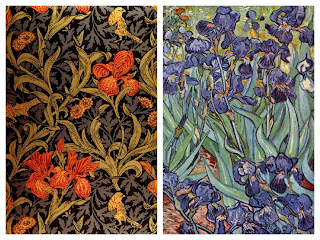Many of my
ancestors lived quietly doing good works in small ways, and a lot of the
articles I write here are intended to rescue their memory and example from
obscurity. It’s as if by naming the dead and remembering their deeds I am
keeping them alive.
Others had more
illustrious careers, were even celebrated in their day, but are now forgotten.
John Salter for example, a half cousin of my 2x great grandfather, was a
successful horticulturalist, prominent enough in his sphere to be consulted
about fixity of variegation by Charles Darwin when the naturalist was
researching his second book.
John’s annual
floral displays were a feature of London life, and the flowers which he
created, especially varieties of chrysanthemum, remained popular in the garden
catalogues for 120 years. It was his chrysanthemums that first caught my eye,
because he named some of them after family members. Later someone drew my
attention to his fascination with variegated varieties of many other plants.
And more recently I stumbled across a beautiful iris which he introduced, Gypsy
Queen.
Iris Gypsy Queen (Salter before 1859)
I can imagine
John being fascinated by the big, beautiful, blousy, bearded iris. There seems
to be an infinite variety in its colours and veining, and it must have been an
ideal vehicle for his skill as a crossbreeder. His interest in iris (with its
Latin origin, the plural of iris is iris, not irises!) began relatively early
in his career. A silver salver, still owned by his descendants today, was
awarded to him in 1834 while he was still in his thirties. It is engraved:
presented to JOHN SALTER Shepherd's Bush.
For ROSES, IRIS and DAHLIAS 1834
I wish we knew
the occasion on which it was presented. The tray itself is much older than the
inscription – 1756, according to the hallmarks.
The silver salver presented to John Salter in 1834
Having found
Gypsy Queen, I came across two more of Salter’s iris, Fairy Queen and Queen of
May – his iris Queens probably had some hybrid connection, just as for example
his chrysanthemum Empress of India, named in honour of Queen Victoria, was a
sport of his big-selling chrysanthemum Queen of England.
Iris Fairy Queen and Queen of May (both Salter before
1859)
I was impressed
to find as many as three Salter iris. But the website Iris Paradise lists some sixteen
varieties which John registered before 1859,
at least seven of which can still be found growing today, more than 150
years later. (The Historic Iris Preservation Society of America considers an
iris historic if the variation is a mere 30 years old.)
Left to right, top to bottom: Iris Bridesmaid, Fabian, Ignacite and Mexicana (all
Salter before 1859)
Sixteen! And
then this morning, while writing this article, I found an item in The Gardener’s Chronicle, a nineteenth
century magazine, reproduced in the New Zealand based blog Heritage Irises. In the
Amateurs Column of the issue of 14th July 1894, Harrison Weir of
Sevenoaks writes:
I
commenced the culture of Iris by buying about fifty sorts or varieties of Mr.
Salter, of Hammersmith, years ago. I now find several of these have another
name … yet I intend to call them by the names I have known them by, and were
given to them by their skilful raiser, Mr. Salter.
It really was
years ago. By 1894 Weir was himself an enthusiastic iris breeder of some thirty
years experience, and Salter’s Hammersmith nursery closed in about 1870. This
rediscovering and renaming of varieties is a constant headache for the iris
historian. Salter’s Bridesmaid, for example, is virtually identical to Michael
Foster’s Mrs Horace Darwin, dedicated to the wife of Charles Darwin’s son in
1888.
Iris Mrs Horace Darwin (Foster M. 1888)
But fifty! Weir names
many of them. His descriptions of them, and other descriptions in iris catalogues from the
early twentieth century, paint such vivid colourful pictures that it’s easy to
see why artists of the time were drawn to them. Even though many of John Salter’s
iris are now extinct, they are kept alive by those word-pictures and the images
they conjure.
L: William Morris’s Iris textile pattern (1885),
and R: Vincent Van Gogh’s Irises (1889)









As for the chrysanthemums, in 1865 John Salter published The Chrysanthemum: its history and Culture and as The Garden Chronicle said in April of that same year, 'When Mr Salter discourses on Chrysanthemums it is the Oracle that speaks'.
ReplyDeleteYou may find information about the tray as in 1832 John Salter became a founding member of the Metropolitan Society of Florists and Amateurs, and was particularly successful with Roses, Dahlias and Irises.Two years later he left Shepherds Bush to set up as a professional nurseryman in France at Versailles. You will find more information in the book 'West London Nursery Gardens' published by the Fulham and Hammersmith Historical Society.
My blog which you have linked above is Heritage Irises not Historic Irises
Salter's book on Chrysanths is still available as a print-on-demand facsimile, although the plates aren't very well reproduced. Thanks for your information about his membership of the MSFA; and sincere apologies for naming your blog wrongly (confused by the web address!) which is a tremendous blog and worth the attention of anyone reading my own article.
ReplyDelete